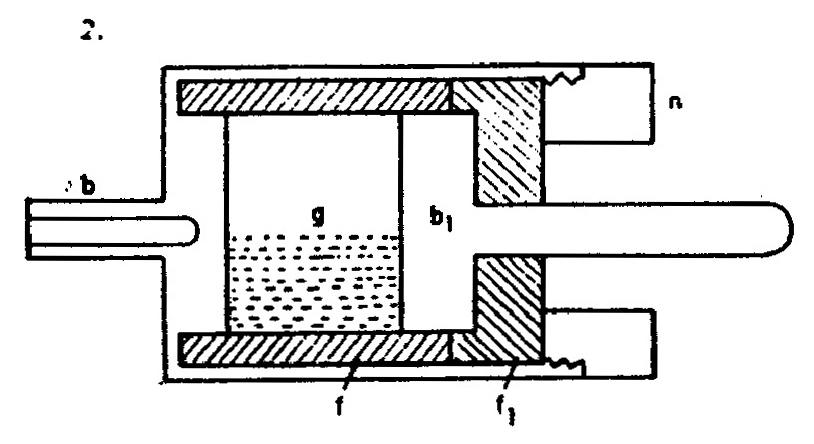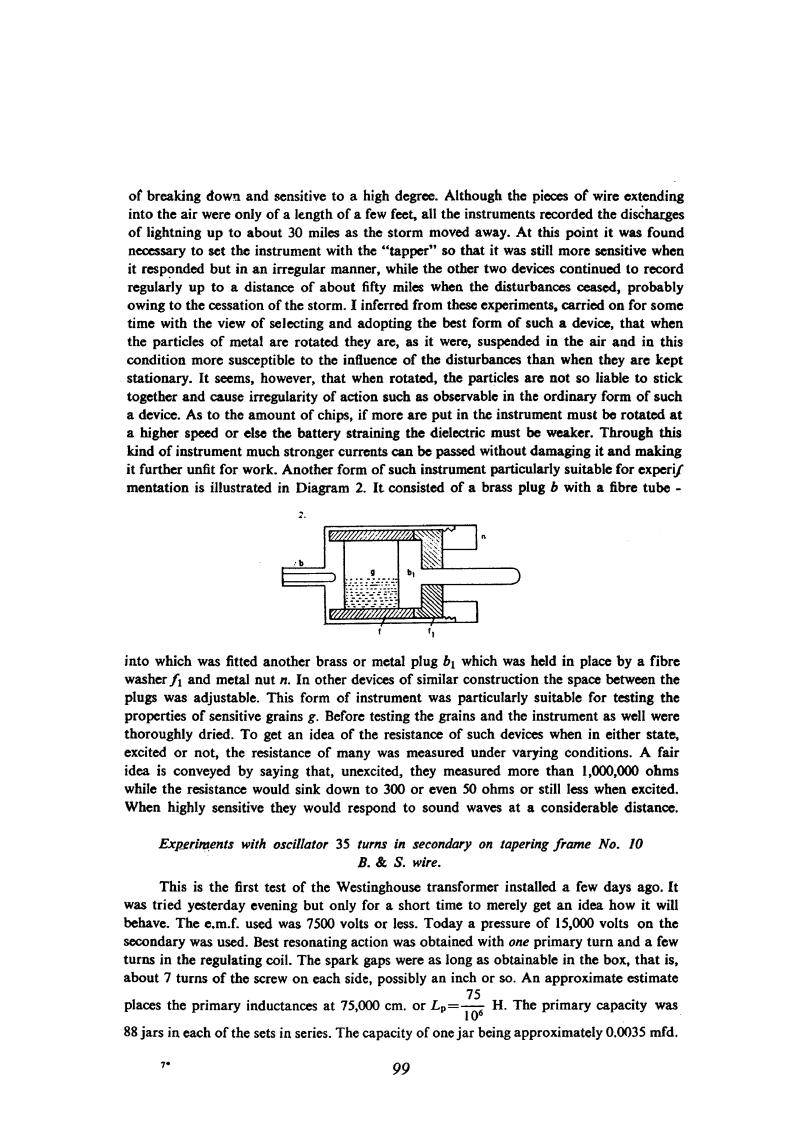
Nikola Tesla Books
of breaking down and sensitive to a high degree. Although the pieces of wire extending into the air were only of a length of a few feet, all the instruments recorded the discharges of lightning up to about 30 miles as the storm moved away. At this point it was found necessary to set the instrument with the âtapperâ so that it was still more sensitive when it responded but in an irregular manner, while the other two devices continued to record regularly up to a distance of about fifty miles when the disturbances ceased, probably owing to the cessation of the storm. I inferred from these experiments, carried on for some time with the view of selecting and adopting the best form of such a device, that when the particles of metal are rotated they are, as it were, suspended in the air and in this condition more susceptible to the influence of the disturbances than when they are kept stationary. It seems, however, that when rotated, the particles are not so liable to stick together and cause irregularity of action such as observable in the ordinary form of such a device. As to the amount of chips, if more are put in the instrument must be rotated at a higher speed or else the battery straining the dielectric must be weaker. Through this kind of instrument much stronger currents can be passed without damaging it and making it further unfit for work. Another form of such instrument particularly suitable for experimentation is illustrated in Diagram 2. It consisted of a brass plug b with a fibre tube - into which was fitted another brass or metal plug b1 which was held in place by a fibre washer Æ1 and metal nut n.
In other devices of similar construction the space between the plugs was adjustable. This form of instrument was particularly suitable for testing the properties of sensitive grains g. Before testing the grains and the instrument as well were thoroughly dried. To get an idea of the resistance of such devices when in either state, excited or not, the resistance of many was measured under varying conditions. A fair idea is conveyed by saying that, unexcited, they measured more than 1,000,000 ohms while the resistance would sink down to 300 or even 50 ohms or still less when excited. When highly sensitive they would respond to sound waves at a considerable distance.
Experiments with oscillator 35 turns in secondary on tapering frame No. 10 B. & S. wire.
This is the first test of the Westinghouse transformer installed a few days ago. It was tried yesterday evening but only for a short time to merely get an idea how it will behave. The e.m.f. used was 7500 volts or less. Today a pressure of 15,000 volts on the secondary was used. Best resonating action was obtained with one primary turn and a few turns in the regulating coil. The spark gaps were as long as obtainable in the box, that is, about 7 turns of the screw on each side, possibly an inch or so. An approximate estimate places the primary inductances at 75,000 cm. or $! {Lp = {75 \over 10^{6}}} $! H. The primary capacity was 88 jars in each of the sets in series. The capacity of one jar being approximately 0.0035 mfd.
99
July 23
The device for electrical wave detection which Tesla calls "sensitive device" usually is called 'koherer'. 'Koherer' consists of a tube made of an insulator with the tube terminals between which there is metal powder (metal particles).
Normally, such device has a high electrical resistance, but when a high electromotive force is applied, the resistance is quickly reduced. The process of electrical conductivity increase in a metal powder/carbon mixture when the discharge current from a Leiden jar, passes through them, was described in 1835 by Munk of Rosenschold. In 1856 Varley observed that reduction of metal powder resistance occurs during natural electrical discharges. The important step forward was made by Branly in 1890, when he observed that the electrical spark from the distance acts on metal powder and changes its conductivity. Branly performed numerous experiments with various metal powders and the change of the resistance was determined by means of a galvanometer connected in series with the battery and coherer. In 1894 Lodge* showed that metal powder conductivity could be changed by electromagnetic wave action and that represented the last step before the general introduction of coherer for the purpose of radio waves detection. From the period 1895-1896 the coherers by Marconi and Popov are known(47).
The coherer is the device which once excited, remains in the conductive state. In order to return it again in a poorly conductive state, it has to be mechanically shaken. Mechanical shaking has to be well dosaged and occurring at the right instant. One more improved method of powder decoherance was discovered by Popov, and applied on his receiver for electrical discharges registration. In 1898 Rupp(48) discovered that slow and continuous coherer rotation maintains the powder in a sensitive state. The decoherent characteristic of rotation was previously discovered - as early as 1884 by Calzecchi-Onestia(49).
Tesla mentions that he worked with the rotating coherer in the New York laboratory, and therefore it is possible that he applied the rotation for the purpose of decoheration before Rupp. In comparison with other methods of decoheration, Tesla considers that the rotation method has advantage, because the sensitive device became similar to selensel which conducts when radiation acts upon it. Also, with a rotating speed variation, the sensitivity of the device can be varied, which has advantages. For the purpose of illustration, Tesla gives data on maximum and minimum resistance of sensitive device, and that is one megohm for maximum and 300-50 ohms, or less, for a minimum value. The maximum value is related to non-excited, and minimum to an excited device.
At the end he says that the device reacts to sound from the distance when receiver is adjusted to its maximum sensitivity.
The experiments with the oscillator. In the meantime, starting from July 16, Tesla was preparing new experiments with the transmitter. lle started the testing the day before and continued on June 23. Oscillator adjustment consists of a capacitance choice in the primary circuit, and variation of regulating coil inductance which is the portion of inductance which is the portion of inductance in the primary. The oscillation period is determined from the inductance and capacitance of the primary circuit, "without taking in account the secondary reaction", and that will be approximately accurate in the extraordinary case we have discussed previously.
In the description of sparks which appear at the points under high voltage stress, there are several interesting observations. As for example, the one on current streamers which appear at voltages lower from those at which they could be expected. Tesla considers that the reason for it is that the sphere is not sufficiently polished (and he does not doubt the assumption that it is the consequence of some short impulses, the voltage of which could be considerably higher than the effective voltage in the secondary). By the observation of spark paths, he observes that some deflect and "follow" wooden beams. He checks the radius points of the apparatus where sparks appear (regulating coil, lightning arresters and so on), studies the causes and possible consequences.
He establishes the difficulties due to the oscillator action on bulbs at distances of 40 ft. from open secondary terminal as well. Quite unexpectedly he mentions strange behavior of horses nearby in the field during oscillator operation, and gives a possible explanation. Almost not interrupting the thought, Tesla returns to the question of secondary circuit oscillation method and discharge speed in the primary. He foresees the possibility of use of a rotating mirror by means of which the nature of spark discharge could be established.
* The name "coherer" originates from Lodge and designates the device Which consists of the metal pieces in such state that transitional resistance is high, and it is reduced under the influence o; electrical radiation.


